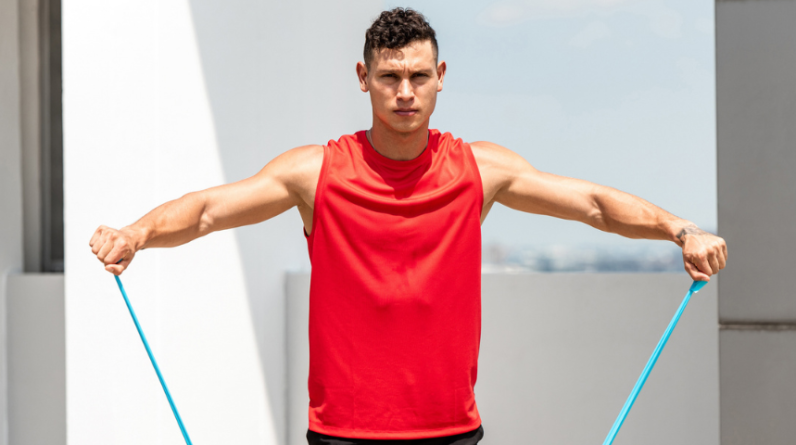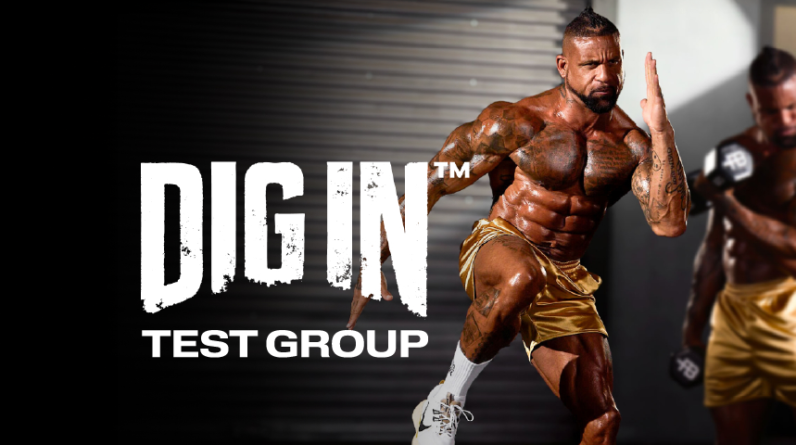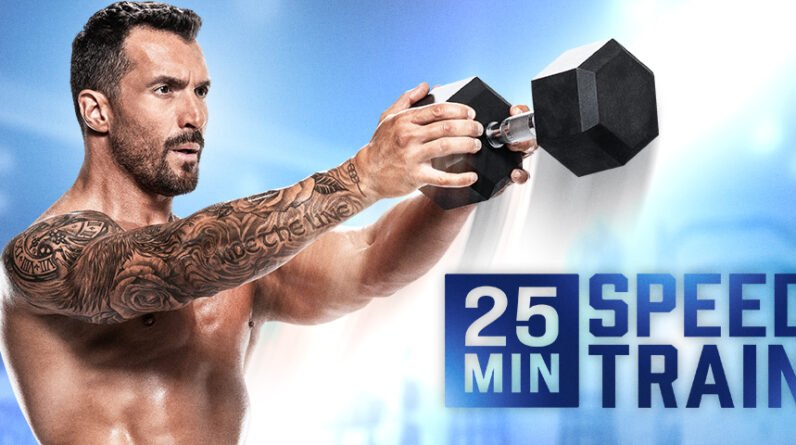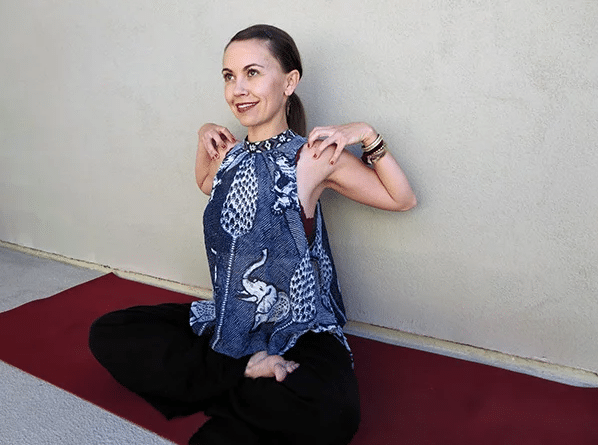
If you want improve the look of your upper body in a hurry, there are probably no movements more important to perform than side delt exercises.
The deltoids — the muscles that lift, rotate, and articulate your upper arms — are visible from virtually any angle and look like halved coconuts on your upper arms and shoulders when they’re well-developed. Powerful side delts create dramatic detail in your upper arm, chest, and upper back, giving a rounded shape to your silhouette that screams, Hell yeah I work out.
That’s a lot of bang for your buck for one part of a single muscle. Here’s how to develop them.
Shoulder Muscle Anatomy
Though we often think of it as a single joint, the shoulder is comprised of multiple joints:
- Glenohumeral joint, the main ball-and-socket joint connecting your upper arm and torso
- Acromioclavicular joint, between your collarbone and your shoulder blade
- Scapulothoracic joint, between your shoulder blade and your rib cage
- Sternoclavicular joint, between your sternum and your collarbone
All these multisyllabic structures contribute to the extreme mobility of the shoulder joint, which allows your arm to move in virtually any direction.
The three-headed deltoid muscle is responsible for a lot of that movement, with each distinct head responsible for moving your upper arm in a particular direction.
The anterior (front) deltoid
The front deltoid runs from the outer end of your collarbone to a spot on the outside of your upper arm called the deltoid tuberosity, a few inches below your shoulder joint. Like the other two heads of the muscle, its primary function is flexion — movement of your arm in a forward direction.
Stand upright and raise your arm forward and up. That’s your anterior delt at work.
The posterior (rear) deltoid
Originating at the outer end of the top edge of your shoulder blade and connecting to the deltoid tuberosity is the posterior deltoid. Its main role is arm extension, or moving your arm backwards behind your body.
If you raise your arm in front of you until it’s parallel to the ground, palm down, then trace a wide arc out to the side and behind you, that’s the main action of the posterior deltoid.
The lateral (side) deltoid
From the acromion, the bony spot on the top of each shoulder where the lateral deltoid originates, the side delt extends down the middle of your upper arm and attaches, like the anterior deltoid, to the deltoid tuberosity.
As its name suggests, the lateral deltoid abducts the arm, lifting it directly out to the side. Since lateral abduction — side-raising — is also a component of overhead pressing and horizontal abduction, the side deltoid also assists the front deltoid in overhead pressing movements and the rear deltoid in many reverse-flying movements.
It’s the muscle in the middle, always up for helping out the other delts.
Benefits of Side Delt Exercises
The side delts may be small — maybe the size and shape of three fingers — but their contribution to the health, function, and appearance of your upper body is outsized.
1. Improved shoulder function
Most people — including many fitness enthusiasts — have front deltoids and upper chests that are disproportionately strong compared to their side and rear deltoids.
This may be due to our tendency to overemphasize pushing movements (bench presses, pushups, etc.) for the chest and shoulders at the expense of pulling moves (rows, pull downs, etc.) for the back. That imbalance can lead to a host of issues, including limited mobility and poor function.
Emphasizing side and rear deltoid development along with front deltoid work can help restore this muscle group to balance, making you more flexible and mobile in overhead reaching and pressing moves.
2. More strength
If the muscles on one side of a joint are significantly stronger than those on the other, the joint can lose stability, which reduces its strength.
By developing the side delts along with the often overpowering front deltoids and upper chest, you’ll help stabilize the shoulder, allowing it to express more strength in overhead pressing movements. Over time, that means more muscle for the entire deltoid — front, sides, and back.
3. An improved silhouette
The side deltoids give your upper body a wider, more muscular look that’s immediately apparent when you walk in a room, even when you’re fully clothed.
Visually, that inch of extra width in shoulders can make the waist appear smaller by comparison, emphasizing the V taper — wide shoulders and back and a narrow waist — that’s the hallmark of fit folks and bodybuilders.
8 Best Side Delt Exercises
If you’re interested in growing and strengthening your lateral delts, these are the best exercises to do so.
1. Cable lateral raise
- Attach a “D” handle to the carabiner on a cable machine and select a light weight on the stack.
- Holding the handle in your left hand, stand with your right shoulder facing the machine with your right foot forward, and the toe of your left foot against the heel of your right, as if walking on a tightrope.
- Take hold of the upright on the cable machine with your right hand and lean your body to the left, keeping your shoulders and hips square. This is your starting position.
- Keeping your right arm straight and the palm of your left hand turned downwards, slowly raise the D handle out to your left side until your arm is parallel to the floor.
- Hold the top position for a moment, reverse the move, return to the starting position, and repeat for reps on both sides.
2. Dumbbell lateral raise
- Stand tall with your feet hip-width apart, holding a pair at dumbbells at arms’ length by your sides, palms facing inward.
- Maintaining a slight bend in your elbows, raise your arms directly out to your sides until they’re at shoulder level (your palms should be facing downward at the top of the movement).
- Slowly lower the weights back to the starting position.
3. Resistance band lateral raise
- Stand in the middle of a band and place each hand in a handle. Brace your core, and keep the band in place with your foot.
- Lift the band out to the sides to shoulder level, and hold for a beat before you return to start.
4. Resistance band face pull
- Anchor a resistance band to a stable point several inches above your head.
- Facing the anchor point, grab the band with an overhand grip, keeping your hands about six inches apart.
- Step back from the anchor point with your arms extended in front of you until you feel tension in the band.
- Keeping your back straight and elbows high, pull the band toward your face, stopping once the band approaches your nose.
- Slowly reverse the move to return to the starting position, and repeat for reps.
5. Upright row
- Stand holding a pair of dumbbells at arm’s length in front of your waist, palms facing toward you.
- Slowly lift the weight in front of your torso, keeping it close to your body, until your elbows reach shoulder height.
- Pause, then reverse the movement, lowering the weights back to the starting position.
6. Arnold press
- Hold two dumbbells in front of your chest with your palms facing toward your body, keeping your elbows close to your body. This is your starting position.
- Press the dumbbells up above your head, rotating your palms out so that when you reach the overhead position, they face away from your body.
- Reverse the motion to lower the dumbbells back down, corkscrewing your hands so your palms end facing your body, and repeat.
7. Military press
- Adjust an incline bench so the back is vertical and sit on the seat, holding two heavy dumbbells at shoulder height, palms facing forward.
- Slowly press the dumbbells upward until your arms are straight.
- Lower your hands back to your shoulders and repeat.
8. Callahan press
- Stand with your feet hip-width apart, holding a dumbbell in each hand. Raise your hands up to a field goal position: upper arms parallel to the ground and aligned with your shoulders, elbows bent at 90 degrees, palms facing forward, and hands pointed toward the ceiling. This is the starting position.
- Bring your forearms in front of you and turn your palms in toward one another. Then reverse the movement to return to the starting position.
- Press the weights directly above your shoulders, and then reverse the movement to return to the starting position.
- Repeat this sequence for reps.
Tips for Side Delt Exercises
To get the most out of your side delt work, follow these tips.
1. Don’t overwork them
The side deltoid is one part of a major muscle group and is stimulated whenever you perform presses or rows of any kind, so they don’t need too much isolation work.
Three or four sets of two exercises per week is plenty for most people. Once you’ve been working out for six months or more, shoot for a total of 10 to 20 sets for your deltoids per week. Either way, keep your reps at eight or more per set.
2. Pair them with a comprehensive training program
You can work your deltoids as part of a full-body program (where you perform about three sessions per week, each hitting all the major muscles) or as part of a split system (in which you divide your body into different muscle groups and work them on different days of the week).
3. Train them first in your workouts
Whether you train full-body or splits, if your deltoids are a priority, work them first in a routine, especially if you’re also working your chest in the same workout.
4. Maintain proper form
Here are some form tips to keep in mind when performing side delt exercises:
- Stand upright with your head in a neutral position as you perform deltoid moves; don’t thrust your head forward as you perform each rep.
- Keep your elbows slightly bent and your palm facing downwards throughout all lateral-raise exercises.
- Perform the eccentric — or lowering — portion of all deltoid exercises slowly and under control.
- Get a full stretch in the down position of every exercise.
- Focus on creating a strong mind-muscle connection throughout all side-deltoid movements; feel the muscles working and eliminate all swinging and cheating.
- Don’t overload side deltoid exercises. Instead, focus on perfect execution at a moderate to slow pace.







